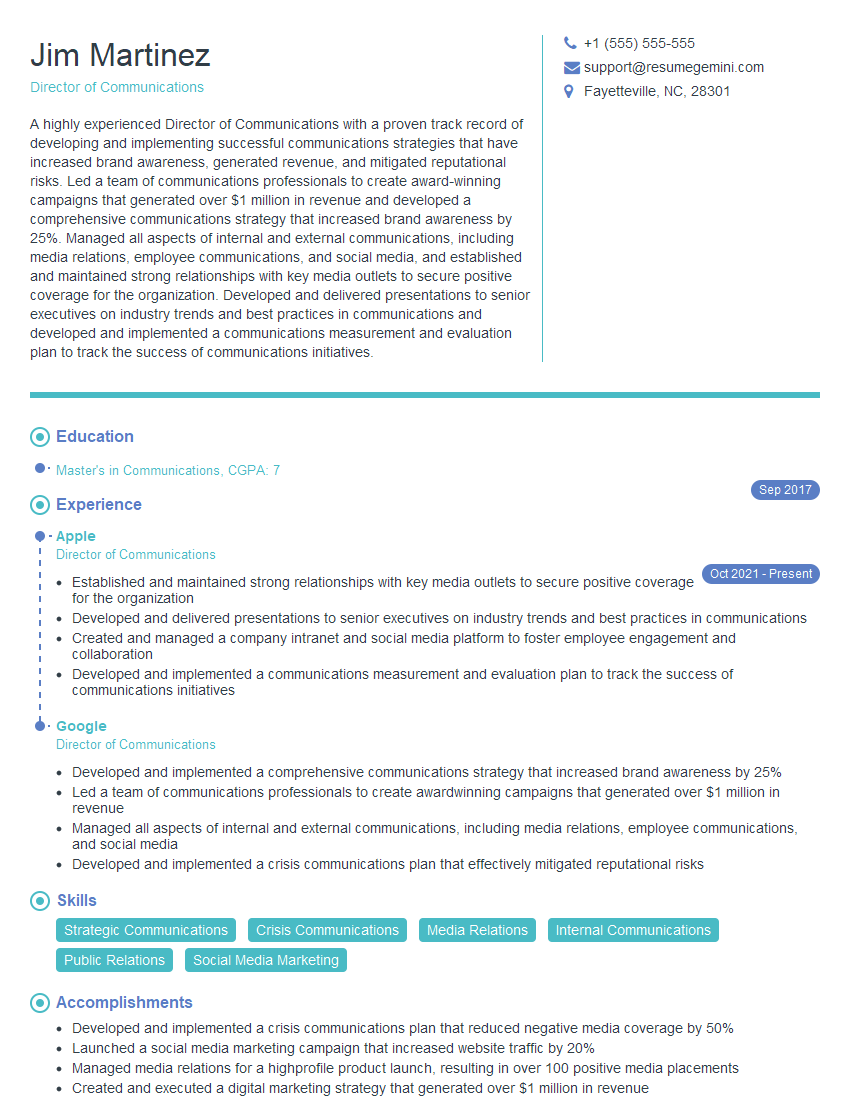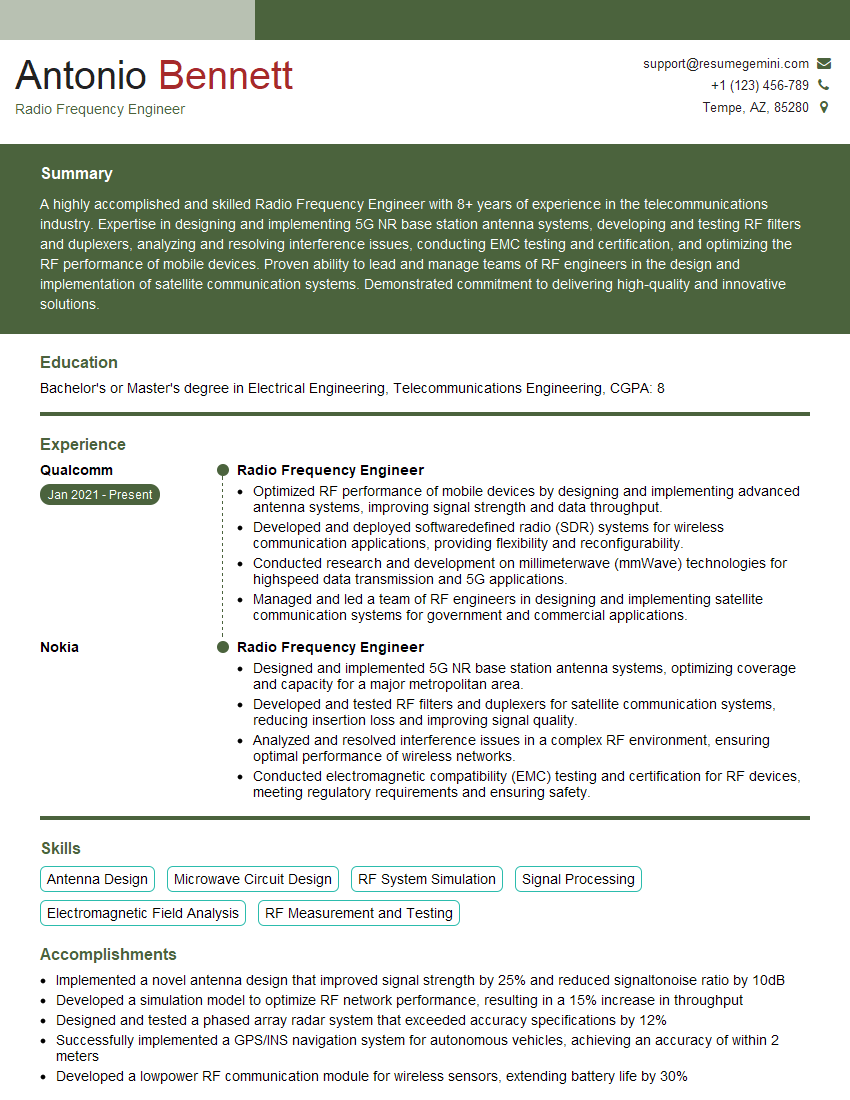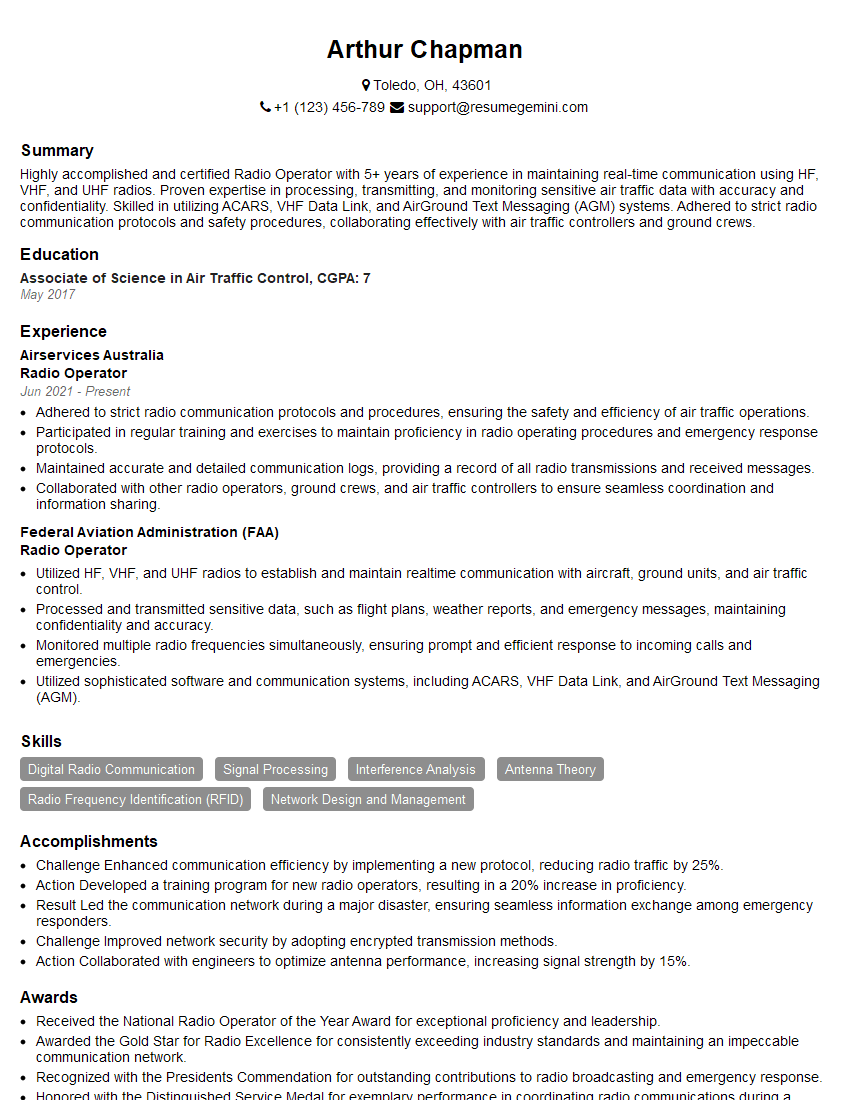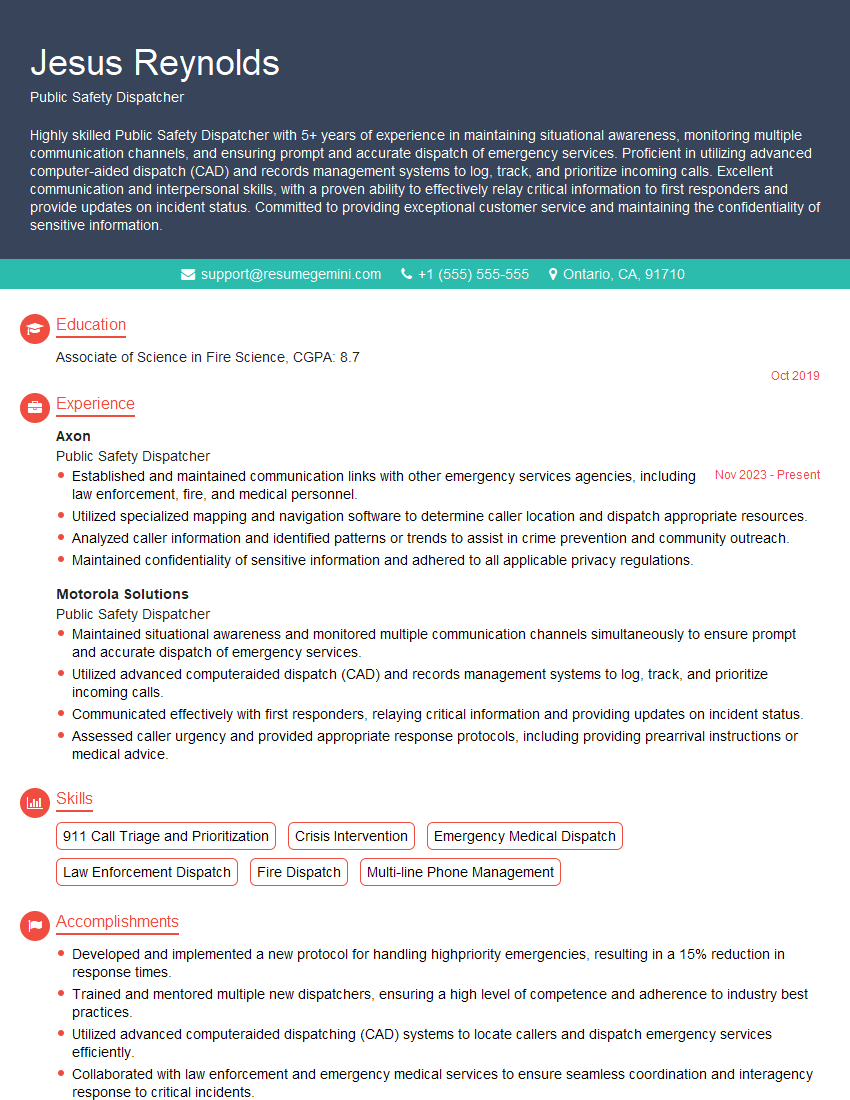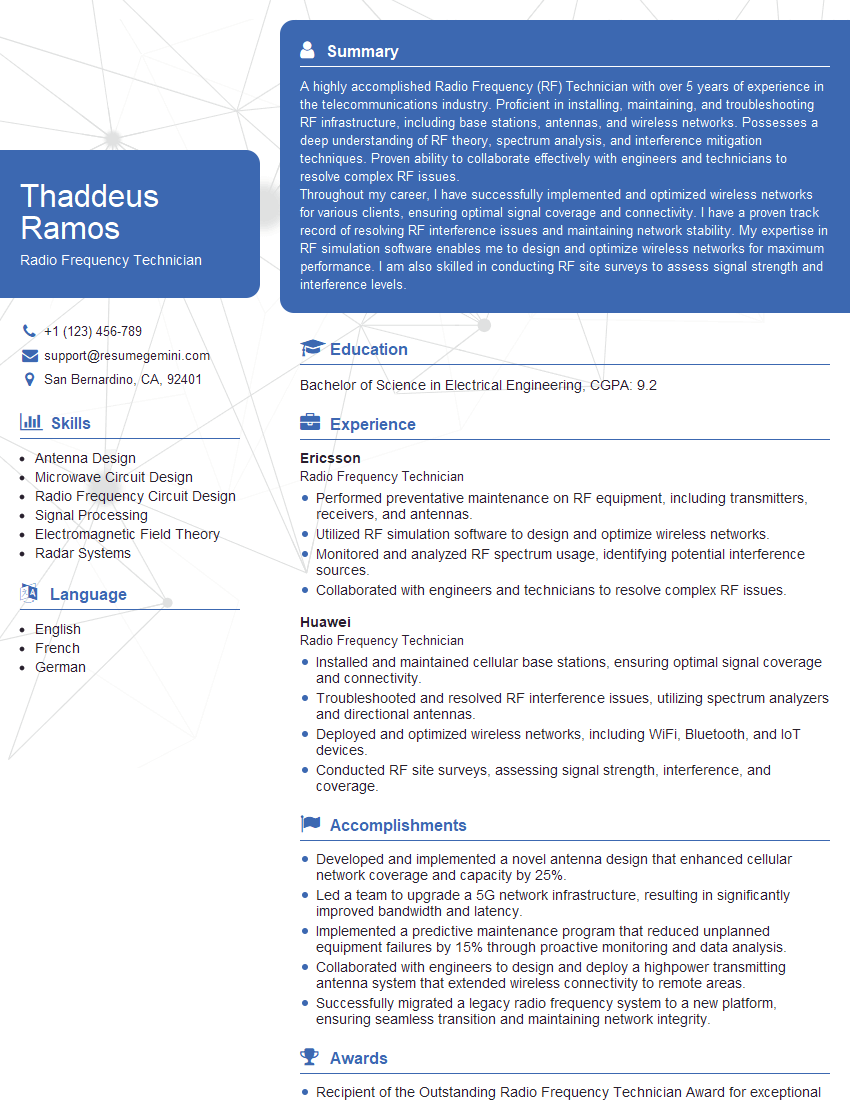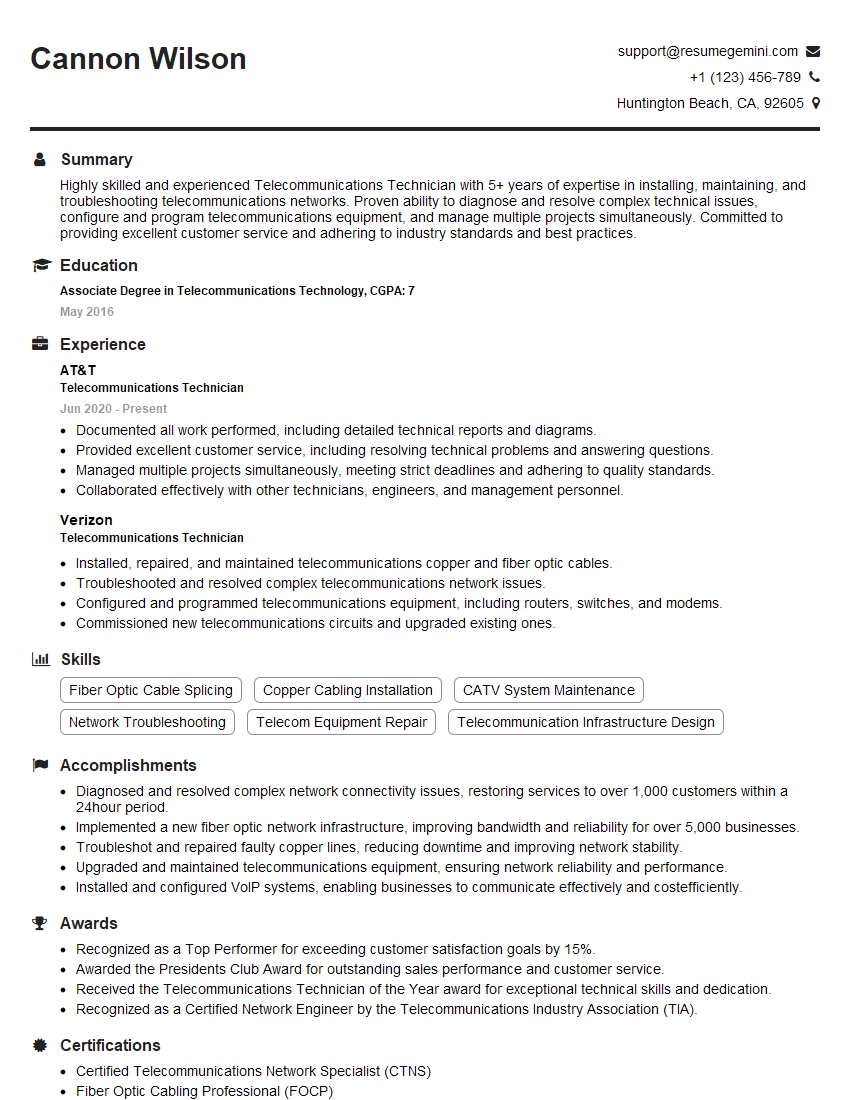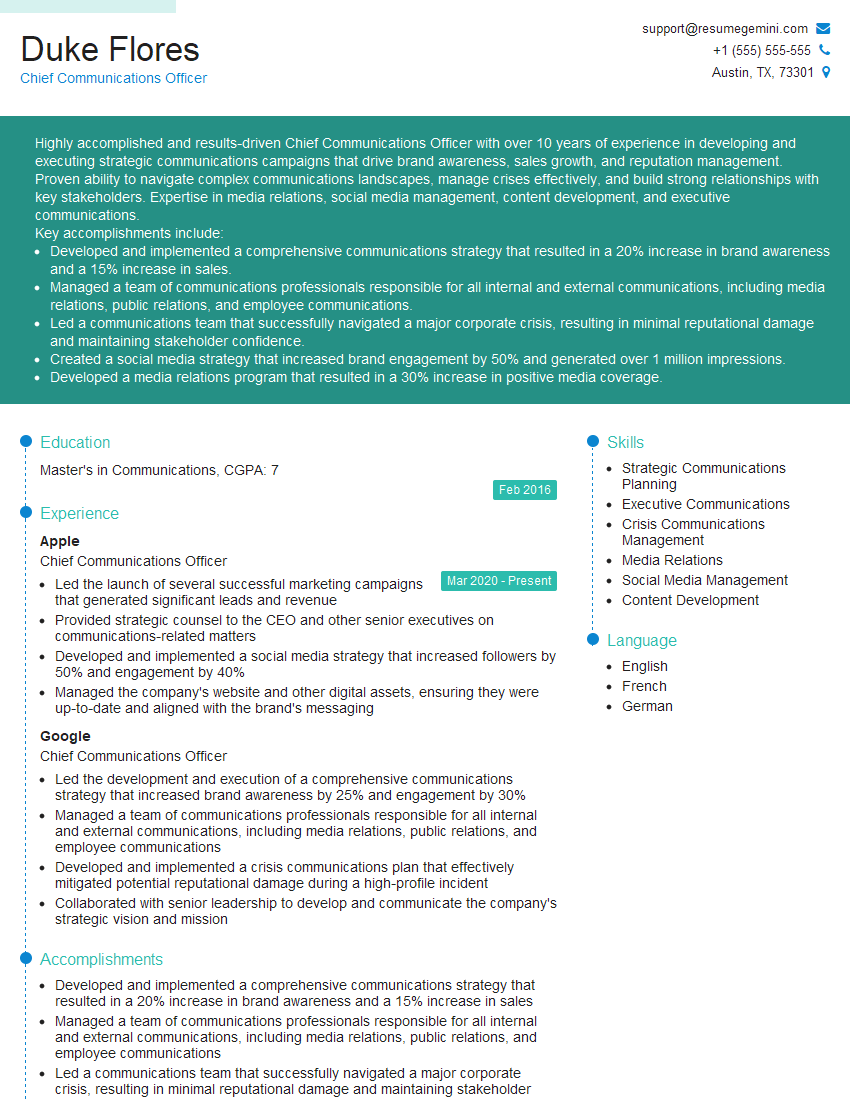Interviews are opportunities to demonstrate your expertise, and this guide is here to help you shine. Explore the essential Operating radios and other communication equipment interview questions that employers frequently ask, paired with strategies for crafting responses that set you apart from the competition.
Questions Asked in Operating radios and other communication equipment Interview
Q 1. Explain the difference between AM and FM radio transmissions.
AM (Amplitude Modulation) and FM (Frequency Modulation) are two different methods for transmitting radio signals. The key difference lies in how the information (audio) is encoded onto the radio wave. In AM, the amplitude (strength) of the radio wave is varied to represent the audio signal. Think of it like a ripple in a pond – the height of the ripple changes to reflect the sound. In FM, the frequency (number of cycles per second) of the radio wave is varied. This is more like varying the speed at which the ripples travel.
AM is more susceptible to noise and interference, resulting in a crackly or static sound, especially during poor reception conditions. FM, being less susceptible to noise, generally offers cleaner, higher-fidelity audio. However, FM signals tend to have a shorter range than AM signals. You’ll often find AM used for long-distance broadcasts because its signals can travel further, while FM is better suited for local broadcasts aiming for higher sound quality.
Consider this: Imagine you’re trying to send a message by varying the brightness of a lightbulb (AM) versus varying how quickly the lightbulb flashes (FM). A bright lightbulb could easily be dimmed by clouds or other obstacles (interference), affecting your message, whereas flashing quickly is harder to disrupt.
Q 2. Describe the process of troubleshooting a malfunctioning radio.
Troubleshooting a malfunctioning radio involves a systematic approach. First, I’d verify the obvious: is the radio turned on? Are the batteries fresh (if applicable)? Is the antenna properly connected and extended? Next, I’d check the volume and select a known-good station. If there’s no reception, I’d move to more in-depth checks. This could involve:
- Checking Connections: Inspect all wiring, ensuring secure connections to the power source, antenna, and any external speakers or accessories.
- Antenna Issues: Poor antenna connection or damage can significantly impact reception. Try a known-good antenna if one is available.
- Power Supply: Check the power supply for voltage and current issues, ensuring it meets the radio’s specifications. A faulty power supply is a common culprit.
- Internal Components: If the problem persists, it may require opening the radio (after power is disconnected) to inspect internal components for signs of damage or loose connections. This usually calls for a skilled technician, unless you’re experienced in radio repair.
- Software/Firmware Issues: Some modern radios have software components. A software update or reset might resolve problems. Consult the user manual for this procedure.
Throughout the process, I’d maintain detailed notes, documenting each step and observation, aiding in identifying the root cause of the malfunction. If the problem is beyond my capabilities, I’d consult relevant service manuals or seek assistance from qualified radio technicians.
Q 3. What are the common causes of radio interference?
Radio interference, or static, can originate from various sources. These can be broadly categorized as:
- Atmospheric Interference: Static from lightning, solar flares, or other atmospheric events can disrupt radio signals. This is often heard as crackling or popping sounds.
- Man-made Interference: This is a broader category including:
- Electrical Devices: Appliances like motors, switching power supplies, and fluorescent lights can generate interference.
- Other Radio Transmitters: Signals from nearby radio stations or other wireless devices operating on similar frequencies can cause interference.
- Power Lines: High-voltage power lines often generate significant interference.
- Industrial Equipment: Motors, welders, and other industrial equipment can emit strong electromagnetic interference (EMI).
- Multipath Interference: This occurs when radio signals travel multiple paths before reaching the receiver. This can result in a fading or ghosting effect, where the signal weakens and strengthens unpredictably.
Identifying the source of interference is crucial for mitigating it. Using a directional antenna to pinpoint the strongest sources of interference is one technique. Filtering the signals at both the transmitting and receiving ends can also help reduce interference, as can adjusting frequencies or using shielded cables.
Q 4. How do you ensure clear and effective communication using radio equipment?
Clear and effective radio communication requires adherence to several principles:
- Proper Procedures: Following established communication protocols, such as using standardized phrases and procedures (e.g., ‘over’, ‘out’, etc.), ensures clear understanding and avoids confusion.
- Clear and Concise Messaging: Messages should be brief, to the point, and easily understood. Avoid technical jargon unless the audience understands it.
- Proper Antenna Placement and Orientation: A correctly placed and oriented antenna maximizes signal strength and minimizes interference.
- Appropriate Power Levels: Using the lowest power level necessary to achieve effective communication reduces interference and conserves battery power.
- Regular Maintenance and Testing: Regular checks of the radio’s functionality and equipment ensure they are functioning correctly.
- Listen Before Transmitting: Avoid interrupting other communications by listening for activity before transmitting.
- Use of Repeaters: Where appropriate, using repeaters extends range and improves signal clarity by retransmitting the signal.
Think of it like a well-run meeting – clear structure, concise speech, and active listening ensures everyone is on the same page.
Q 5. What safety procedures do you follow when operating radios?
Safety procedures when operating radios vary based on the context, but some general principles apply:
- Proper Antenna Handling: Never touch the antenna while transmitting, as this could expose you to RF radiation.
- RF Exposure Limits: Be aware of RF exposure limits and maintain safe distances from high-power transmitters. These limits vary depending on the frequency and power level.
- Emergency Procedures: Know how to use the radio for emergency communications and have a plan for contacting emergency services.
- Environmental Awareness: Be mindful of your surroundings. Avoid using radios in hazardous environments without the proper safety precautions.
- Battery Safety: Handle radio batteries with care. Rechargeable batteries can be hazardous if mishandled. Follow manufacturer’s guidelines on charging and handling.
- Authorized Personnel Only: Ensure that only authorized personnel operate the radios.
Safety is paramount when working with radio equipment. Always prioritize safety and follow all manufacturer recommendations.
Q 6. Explain your understanding of radio frequency (RF) safety.
Radio Frequency (RF) safety is crucial because exposure to high levels of RF radiation can be harmful. The level of harm depends on several factors: frequency of the radiation, power level, duration of exposure, and proximity to the source. Excessive exposure can lead to overheating of body tissues, and in extreme cases, burns or other health issues.
Understanding the RF safety guidelines and regulations, such as those set by regulatory bodies (like the FCC in the US), is vital. These guidelines define limits of safe exposure for various frequencies and power levels. It’s important to select and operate equipment that complies with these standards and to use protective measures, such as reducing exposure time, increasing distance from the source, or using shielding if necessary. Maintaining a safe operating distance from transmitting antennas is a critical safety precaution.
Think of it like the sun – a little sunlight is beneficial, but prolonged exposure without protection can cause sunburn. RF radiation is similar; moderate exposure generally poses minimal risk, but excessive exposure needs to be avoided.
Q 7. How do you handle emergency situations using radio communication?
Handling emergency situations with radio communication requires clear, concise, and accurate reporting. The steps I would take include:
- Maintain Calmness: Stay calm and focused to provide clear information.
- Accurate Location Reporting: Provide precise location coordinates (latitude and longitude, if possible) to enable swift response.
- Detailed Description of the Emergency: Clearly describe the nature of the emergency, including injuries, the number of people involved, and any immediate hazards.
- Prioritization of Information: Convey the most crucial information first – what is the immediate threat? How many people need help? Where are they?
- Maintain Communication: Continue updating responders with any changes in the situation until help arrives.
- Use of Emergency Channels: Use designated emergency channels and frequencies to ensure your message reaches the right people quickly.
- Follow Emergency Procedures: Follow pre-established emergency communication procedures to ensure efficient response and avoid confusion.
In an emergency, efficient and clear communication is life-saving. Regular training and drills are essential to prepare for such situations.
Q 8. Describe your experience with different types of radio systems (e.g., VHF, UHF, HF).
My experience encompasses a wide range of radio systems, from the commonly used VHF (Very High Frequency) and UHF (Ultra High Frequency) to the longer-range HF (High Frequency) systems. VHF and UHF are excellent for shorter-range communications, typically used in land mobile radio (LMR) systems such as police, fire, and emergency medical services. These frequencies are relatively unaffected by atmospheric conditions, providing reliable communication within line-of-sight limitations. Think of a local construction site or a police department using UHF radios – clear, crisp communication within a defined area. HF, on the other hand, operates on longer wavelengths, allowing for long-range communication even beyond the horizon. This is achieved through skywave propagation, where radio waves bounce off the ionosphere. HF is critical in maritime and aviation applications, as well as in remote areas where VHF/UHF coverage might be limited. Imagine a cargo ship communicating with a coastal station hundreds of miles away – that’s HF in action. I’ve worked extensively with all three, understanding their strengths and weaknesses, and selecting the most appropriate system for various operational requirements.
- VHF: Experienced in configuring and operating various VHF systems, including trunking systems, for effective dispatch and fleet management.
- UHF: Proficient in troubleshooting and maintaining UHF radios in diverse environments, including rugged terrain and urban settings.
- HF: Skilled in operating and maintaining HF radios, including frequency management and antenna tuning for optimal long-range communication.
Q 9. What is your experience with radio maintenance and repair?
Radio maintenance and repair is a core part of my expertise. I’m adept at troubleshooting a wide array of issues, from simple antenna problems to complex internal circuitry faults. My approach is methodical, starting with a visual inspection, followed by systematic testing using specialized equipment like spectrum analyzers and signal generators. I’m experienced in repairing various components, including power supplies, transmitters, receivers, and control units. I also understand preventative maintenance procedures, ensuring optimal radio performance and extending their lifespan. For instance, I once diagnosed and repaired a VHF radio experiencing intermittent transmission issues by identifying a faulty filter capacitor within the transmitter circuit. This involved carefully desoldering the faulty component, installing a replacement, and thoroughly testing the repaired unit to ensure optimal performance. Proper documentation is key, and I maintain detailed records of all repairs performed, including the problem, the solution, and any preventative maintenance actions undertaken.
Q 10. How familiar are you with radio licensing and regulations?
I have a thorough understanding of radio licensing and regulations. This includes familiarity with the licensing procedures, frequency allocation rules, and operational guidelines set by relevant authorities like the Federal Communications Commission (FCC) in the US or equivalent bodies in other countries. I understand the importance of adhering to these regulations to ensure safe and efficient operation while preventing interference with other radio systems. I’m aware of the consequences of non-compliance, including fines and license revocation. My experience includes assisting in license applications, ensuring compliance with technical standards, and managing frequency coordination with other users to minimize interference. I can interpret technical specifications and ensure that the chosen frequencies and power levels are compliant with the relevant regulations for the specific location and type of operation.
Q 11. Explain your experience with encryption and secure radio communications.
Experience with encryption and secure radio communications is paramount in many operational environments. I’m familiar with various encryption techniques, ranging from simple voice scrambling to more sophisticated digital encryption algorithms. This includes experience with both hardware and software-based encryption solutions. Understanding the security implications and vulnerabilities is key. For example, I’ve worked with radios employing AES (Advanced Encryption Standard) encryption to protect sensitive information during transmission. I’m also aware of the importance of key management and regularly updating encryption keys to maintain security. Furthermore, I understand the necessity of implementing robust security measures beyond encryption, such as secure access control and regular system audits, to protect against unauthorized access and potential breaches. I can help assess the security requirements of a communication system and recommend suitable encryption and other security measures.
Q 12. Describe your experience with different antenna types and their applications.
I’m experienced with various antenna types and their applications. The choice of antenna depends heavily on the frequency range, the desired coverage area, and the environmental factors. I have worked with different types such as:
- Whip antennas: Simple, compact, and commonly used for mobile applications.
- Dipole antennas: Provide a good balance of gain and bandwidth, suitable for base stations and fixed installations.
- Yagi-Uda antennas: High-gain directional antennas, excellent for point-to-point communication over long distances.
- Helical antennas: Circularly polarized antennas that maintain signal strength despite changes in orientation. These are vital for satellite communication.
Understanding the antenna’s radiation pattern is crucial for optimizing communication range and minimizing interference. I know how to select and install antennas to maximize performance, taking into account factors like ground effects and nearby obstacles. For instance, selecting a high-gain directional antenna for a long-range link and a more omnidirectional antenna for a broad coverage area.
Q 13. How do you prioritize multiple radio calls or transmissions?
Prioritizing multiple radio calls or transmissions requires a structured approach and sound judgment. The system used depends on the radio system and its capabilities. In simple systems, it often comes down to operator skill and established protocols. However, in more sophisticated dispatch systems, software manages call prioritization based on pre-defined rules and the urgency of the call. This might involve assigning different priority levels to different types of calls, giving precedence to emergency situations over routine communications. It may also involve call queuing and automatic routing. I’m experienced in using such systems and understand how to quickly assess the urgency of multiple calls, deciding which requires immediate attention. This includes understanding the specific needs of emergency services and applying established procedures to guarantee efficient communication and response.
Q 14. What is your experience with radio dispatch software?
I have extensive experience with radio dispatch software, including systems designed for managing large fleets of vehicles or responding to emergency calls. My familiarity includes software packages used for dispatching, monitoring, and managing radio communications. I understand how these systems work, including features like call logging, position tracking (GPS integration), automated alerts, and reporting capabilities. I’ve worked with different interfaces, from simple console-based systems to complex networked applications with sophisticated mapping and data visualization. For instance, I’ve utilized software that allowed for efficient routing of emergency response units based on real-time location data and call prioritization. I know how to configure these systems, train users, and troubleshoot technical issues that might arise during operation. Furthermore, I understand the importance of data backup and security within these systems to maintain the integrity of the communication and tracking data.
Q 15. How do you handle difficult or stressful situations during radio operation?
Handling stressful situations during radio operation relies on a combination of training, preparation, and a methodical approach. My training emphasizes maintaining composure under pressure. This includes practicing clear communication techniques, even when facing technical difficulties or time constraints. For example, during a large-scale emergency, I’ve found that using standardized phraseology and prioritizing information significantly reduces confusion and improves team coordination. If the situation involves a critical failure, I follow established troubleshooting procedures, systematically checking equipment settings and connections. If the issue persists, I immediately escalate the problem to the appropriate supervisor, ensuring clear and concise communication of the problem’s nature and impact.
Stress management techniques such as deep breathing and maintaining situational awareness are essential. I also regularly review emergency response plans and procedures to ensure I am always prepared for unexpected challenges. Regular practice and drills help build confidence and reduce anxiety in high-pressure scenarios. Essentially, it’s about combining technical proficiency with strong mental preparedness.
Career Expert Tips:
- Ace those interviews! Prepare effectively by reviewing the Top 50 Most Common Interview Questions on ResumeGemini.
- Navigate your job search with confidence! Explore a wide range of Career Tips on ResumeGemini. Learn about common challenges and recommendations to overcome them.
- Craft the perfect resume! Master the Art of Resume Writing with ResumeGemini’s guide. Showcase your unique qualifications and achievements effectively.
- Don’t miss out on holiday savings! Build your dream resume with ResumeGemini’s ATS optimized templates.
Q 16. What is your understanding of radio frequency spectrum management?
Radio frequency spectrum management is the process of regulating the use of radio frequencies to prevent interference and ensure efficient use of this valuable resource. It involves allocating specific frequency bands to different users and services, adhering to international and national regulations. Understanding spectrum management is crucial for avoiding costly fines and ensuring reliable communication. For instance, operating on an unauthorized frequency band can lead to severe penalties and disrupt essential services. My understanding encompasses various aspects, including licensing procedures, frequency coordination, and the technical aspects of interference mitigation. I’m familiar with the different types of licenses and the procedures for obtaining them. I also have practical experience in coordinating frequencies with other users to minimize the chances of interference, a common challenge in crowded spectrum environments.
Q 17. Describe your experience working with repeater systems.
I have extensive experience working with repeater systems, including their installation, configuration, and maintenance. Repeaters extend the range of radio communication by receiving and retransmitting signals. This is especially crucial in areas with limited line-of-sight communication. I’ve worked with various repeater technologies, including analog and digital systems. For instance, I’ve been involved in the installation of a digital repeater system for a public safety agency, which significantly improved communication reliability and clarity. This included site selection, antenna installation, and programming the repeater’s control unit to meet their specific communication needs. Troubleshooting repeater systems requires a good understanding of RF principles, network configurations, and control systems. I’ve effectively diagnosed and resolved issues ranging from antenna problems to software glitches, ensuring minimal downtime.
Q 18. How familiar are you with various modulation techniques?
My familiarity with modulation techniques is comprehensive. Modulation is the process of encoding information onto a carrier wave for transmission. Different modulation schemes offer different trade-offs in terms of bandwidth efficiency, power requirements, and resistance to noise and interference. I’m proficient with various techniques, including Amplitude Modulation (AM), Frequency Modulation (FM), Phase Shift Keying (PSK), and Quadrature Amplitude Modulation (QAM). For example, I understand that AM is simple to implement but susceptible to noise, while FM offers better noise immunity but requires more bandwidth. In digital systems, PSK and QAM are commonly used, offering high data rates but requiring more complex signal processing. Choosing the appropriate modulation scheme depends on the specific application and its requirements, considering factors like distance, bandwidth availability, and desired data rate.
Q 19. How do you ensure the accuracy and reliability of radio communications?
Ensuring accuracy and reliability in radio communications involves a multifaceted approach. Firstly, regular equipment maintenance and calibration are essential to minimize errors. This includes checking antenna connections, power levels, and overall system performance. Secondly, using clear and concise communication protocols minimizes misunderstandings and ensures accurate message delivery. Standardized phraseology and checklists help reduce ambiguity. Thirdly, utilizing error correction codes and redundancy mechanisms in digital systems improves the reliability of data transmission. For example, in a critical communication scenario, employing forward error correction (FEC) can significantly improve data integrity even under adverse conditions. Furthermore, signal strength monitoring and the use of appropriate antennas for optimal signal propagation contribute to communication reliability. Regular training and competency assessments for radio operators are vital to maintain consistency and proficiency.
Q 20. What is your experience with testing and calibrating radio equipment?
I possess extensive experience in testing and calibrating radio equipment, using both specialized test equipment and established procedures. Calibration ensures that the equipment operates within its specified parameters. This often involves using signal generators, spectrum analyzers, and power meters to measure key parameters such as frequency accuracy, power output, and modulation quality. For instance, I’ve calibrated handheld radios, base station transceivers, and repeaters, ensuring compliance with regulatory standards and maintaining optimal performance. My experience includes performing routine preventative maintenance checks as well as troubleshooting and repairing faulty equipment. Documentation of all tests and calibrations is vital for maintaining accurate records and ensuring traceability. These procedures are crucial for ensuring the reliability and accuracy of communication systems.
Q 21. Explain your understanding of signal propagation and its impact on radio communication.
Signal propagation refers to how radio waves travel from the transmitter to the receiver. Understanding this is paramount for effective radio communication. Several factors influence signal propagation, including frequency, terrain, atmospheric conditions, and obstacles. For example, higher frequencies generally experience more attenuation and are more easily blocked by obstacles than lower frequencies. Terrain features such as hills and buildings can cause signal reflection, refraction, and diffraction, leading to signal fading or multipath interference. Atmospheric conditions like rain, fog, and ionospheric disturbances can also significantly impact signal quality. Understanding these factors helps in selecting appropriate frequencies and antenna types, optimizing antenna placement, and employing techniques to mitigate signal impairments. For instance, the use of diversity reception, where multiple antennas receive the signal, can significantly improve reliability in multipath environments. Careful consideration of signal propagation is essential for designing robust and reliable communication systems.
Q 22. Describe your experience with different types of radio networks (e.g., mesh, star).
Radio networks can be structured in various ways, each with its strengths and weaknesses. Two common architectures are star networks and mesh networks. In a star network, all communication passes through a central hub, like a base station. This is simple to manage but a single point of failure; if the hub goes down, the entire network is compromised. Think of it like a wheel – the hub is the center, and the spokes are individual radios communicating with it.
Mesh networks, on the other hand, are more resilient. Each radio can communicate directly with multiple other radios, creating multiple pathways for communication. If one radio fails, the network can often reroute communication through other radios, maintaining connectivity. Imagine a spiderweb; if one strand breaks, the overall structure remains largely intact. I’ve worked extensively with both types, implementing star networks for simpler, smaller deployments and mesh networks for larger, more critical applications where redundancy and resilience are paramount, such as disaster relief communication setups.
Beyond star and mesh, I also have experience with hybrid systems that combine aspects of both architectures, offering a balance between simplicity and resilience. The choice of network topology depends heavily on the specific requirements of the application, including geographical coverage, number of users, and tolerance for failure.
Q 23. How do you handle situations with low signal strength or interference?
Low signal strength and interference are common challenges in radio communications. My approach is multifaceted and begins with thorough site surveys to identify potential sources of interference and optimize antenna placement. This often involves analyzing the radio frequency spectrum to identify congested frequencies and selecting less crowded channels.
If signal strength is weak, I consider increasing the power output of the transmitter (within regulatory limits), improving antenna gain, or deploying repeaters to boost the signal. For interference, I might use directional antennas to minimize unwanted signals or employ various filtering techniques to block specific frequencies. I’ve found that careful frequency planning is crucial, often requiring coordination with other users of the same frequency band to avoid interference. Software-defined radios (SDRs) provide advanced signal processing capabilities, allowing for more sophisticated techniques to mitigate interference and improve signal quality. In particularly challenging situations, the use of error correction codes can improve the reliability of communication even in noisy environments.
Q 24. What is your experience with IP-based radio systems?
IP-based radio systems, often referred to as IP radios or digital mobile radios (DMR), are transforming the field of radio communications. My experience includes deploying and maintaining systems that utilize internet protocol (IP) for control and data transmission. This allows for features not possible in traditional analog systems, such as data transfer, remote management, and integration with other IP-based networks.
For example, I’ve worked on projects integrating IP radios with existing computer systems for real-time data logging and analysis. This capability is particularly useful for monitoring environmental conditions or asset tracking. I am also proficient in configuring and troubleshooting VoIP (Voice over Internet Protocol) radio systems, enabling voice communication over IP networks. This technology allows for seamless integration with existing telecommunications infrastructure, offering cost savings and increased flexibility.
Q 25. Explain your understanding of network protocols relevant to radio communications.
Understanding network protocols is crucial for effective radio communication. Many protocols are used, depending on the specific system and application. Some key ones include:
- TCP/IP (Transmission Control Protocol/Internet Protocol): The foundation of the internet, used extensively in IP-based radio systems for data transmission.
- UDP (User Datagram Protocol): A connectionless protocol often used for real-time applications where speed is prioritized over reliability, such as streaming audio or video.
- Ethernet: Commonly used for local area networking within radio systems.
- Proprietary protocols: Many radio manufacturers use their own protocols for system control and data transmission. Familiarity with these is crucial for efficient system operation and maintenance.
My experience encompasses a wide range of these protocols and their practical applications in various radio communication systems. I understand the tradeoffs between different protocols – for example, the reliability of TCP versus the speed of UDP – and how to choose the most appropriate protocol for a given application.
Q 26. How do you maintain accurate logs and records of radio transmissions?
Maintaining accurate logs and records of radio transmissions is essential for several reasons, including regulatory compliance, troubleshooting, and security. My approach involves utilizing a combination of methods, both manual and automated. Automated logging systems capture key information such as time, frequency, signal strength, and transmitted data. For example, many modern radio systems have built-in logging capabilities that can be accessed remotely.
Manual logging might involve maintaining a record of important communications, such as those related to critical incidents or emergency response. These records are kept in a secure and organized manner, often using specialized software or databases. I ensure all logs are securely stored and readily accessible for review and analysis. Proper logging practices are crucial for ensuring accountability and supporting investigations if needed.
Q 27. What is your experience with training others on the use of radio equipment?
I have extensive experience training others on the use of radio equipment. My approach focuses on a blend of theoretical knowledge and hands-on practical experience. I start by providing a clear and concise overview of the equipment’s functions and capabilities, emphasizing safety procedures. The training then moves to practical exercises where trainees get to operate the equipment under supervision.
I tailor my training to the specific needs and experience levels of the trainees, providing customized instruction to ensure effective learning. This includes using a variety of teaching methods, such as presentations, demonstrations, and interactive simulations. I believe in a supportive learning environment where trainees feel comfortable asking questions and practicing their skills. Following the training, I often provide ongoing support and mentorship to ensure that the knowledge gained is applied effectively in real-world scenarios.
Q 28. Describe a time you successfully resolved a complex radio communication issue.
During a large-scale outdoor event, we experienced a significant degradation in communication due to unexpected interference from a nearby unlicensed transmitter. This caused intermittent dropouts and severe audio distortion, disrupting operations. Initial attempts to resolve the issue by simply switching frequencies proved ineffective as the interference was broad-spectrum.
My solution involved a multi-pronged approach: First, I collaborated with the event organizers to identify and temporarily shut down the interfering source. Simultaneously, I implemented a more robust error correction coding scheme on our radios, improving the ability to recover from signal interruptions. Finally, I reconfigured our antenna system to minimize signal overlap and implemented frequency hopping techniques to further mitigate interference. By combining these strategies, we were able to restore reliable communication within an hour, preventing major disruptions to the event. This experience highlighted the importance of proactive planning, rapid problem-solving, and a collaborative approach to tackling complex communication issues.
Key Topics to Learn for Operating Radios and Other Communication Equipment Interviews
- Radio Frequency (RF) Fundamentals: Understanding basic RF principles like frequency, wavelength, modulation, and propagation is crucial. Consider exploring different types of modulation and their applications.
- Radio Communication Systems: Familiarize yourself with various radio systems (e.g., VHF, UHF, HF, digital radios), their operating principles, and limitations. Practice explaining the differences and when to use each type.
- Troubleshooting and Maintenance: Be prepared to discuss common radio malfunctions and troubleshooting techniques. This includes understanding preventative maintenance procedures and safety protocols.
- Communication Protocols and Standards: Knowledge of relevant communication protocols (e.g., DMR, P25) and industry standards is essential. Understand how these protocols ensure efficient and reliable communication.
- Antenna Systems and Propagation: Learn about different antenna types, their characteristics, and how they affect signal transmission and reception. Understand factors affecting signal propagation, like terrain and interference.
- Safety Procedures and Regulations: Demonstrate understanding of safety regulations and procedures associated with operating radios and communication equipment, including emergency procedures.
- Practical Application and Problem Solving: Prepare examples from your experience (or hypothetical scenarios) demonstrating your ability to solve problems related to radio communication, such as signal loss, interference, or equipment malfunction.
- Emerging Technologies: Research advancements in radio communication technology, such as software-defined radios and network-based communication systems. This shows your commitment to staying current in the field.
Next Steps
Mastering the operation of radios and other communication equipment is vital for career advancement in many fields, opening doors to rewarding opportunities and increased responsibility. A strong, ATS-friendly resume is key to getting your foot in the door. ResumeGemini is a trusted resource to help you craft a compelling resume that highlights your skills and experience effectively. They provide examples of resumes tailored to Operating radios and other communication equipment, ensuring your application stands out. Take the next step in your career journey by creating a professional resume that showcases your expertise – start building yours today!
Explore more articles
Users Rating of Our Blogs
Share Your Experience
We value your feedback! Please rate our content and share your thoughts (optional).
What Readers Say About Our Blog
Hello,
We found issues with your domain’s email setup that may be sending your messages to spam or blocking them completely. InboxShield Mini shows you how to fix it in minutes — no tech skills required.
Scan your domain now for details: https://inboxshield-mini.com/
— Adam @ InboxShield Mini
Reply STOP to unsubscribe
Hi, are you owner of interviewgemini.com? What if I told you I could help you find extra time in your schedule, reconnect with leads you didn’t even realize you missed, and bring in more “I want to work with you” conversations, without increasing your ad spend or hiring a full-time employee?
All with a flexible, budget-friendly service that could easily pay for itself. Sounds good?
Would it be nice to jump on a quick 10-minute call so I can show you exactly how we make this work?
Best,
Hapei
Marketing Director
Hey, I know you’re the owner of interviewgemini.com. I’ll be quick.
Fundraising for your business is tough and time-consuming. We make it easier by guaranteeing two private investor meetings each month, for six months. No demos, no pitch events – just direct introductions to active investors matched to your startup.
If youR17;re raising, this could help you build real momentum. Want me to send more info?
Hi, I represent an SEO company that specialises in getting you AI citations and higher rankings on Google. I’d like to offer you a 100% free SEO audit for your website. Would you be interested?
Hi, I represent an SEO company that specialises in getting you AI citations and higher rankings on Google. I’d like to offer you a 100% free SEO audit for your website. Would you be interested?
good

